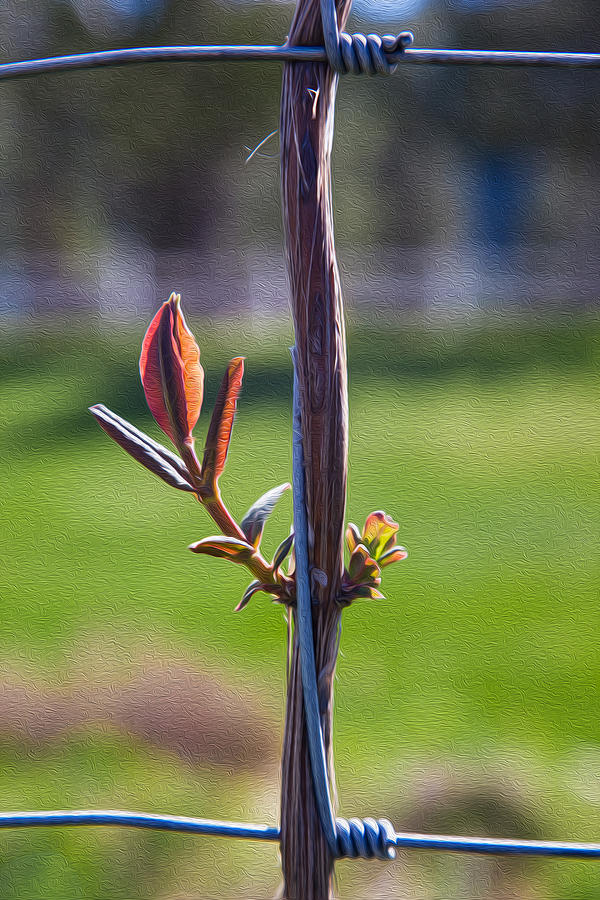
Hopeful Honeysuckle

by Omaste Witkowski
Title
Hopeful Honeysuckle
Artist
Omaste Witkowski
Medium
Painting - Digital Photograph
Description
Hopeful Honeysuckle
Omaste Witkowski
facebook.com/owFotografik
The vine is growing and the flower is just starting to think about coming out and sharing in the warm spring sunshine.
This photograph was taken in Winthrop Wa (Washington State), in the beautiful Methow Valley. The Methow is a small jewel of an area not too far from Seattle in the Pacific Northwest. Okanogan County is such a great place to live for all of the sunshine and outdoors recreation.
My garden in the spring is a magical place to be. Here in Winthrop this flower will show up in about June depending on where exactly you live. Twisp, Winthrop, Mazama and Carlton each have their own time when it blooms. Seattle has a much longer growing season than we do.
----------------
I started with a digital photograph and used a HDR process to tone map the light. Then I applied a finishing oil paint layer to add texture to the overall image. I did some tonal work to even out the colors and make them realistic to what I was seeing in nature but not excessively.
I am interested in photography as an "unusual" or "unique" image making process. In other words I enjoy starting with a photograph of an ordinary scene or subject and then I try to make it my own by adding unusual processing techniques. I hope you enjoy viewing my work as much as i enjoy creating it.
---------------------
Explore the attractive custom framing and matting options available on this page; all are competitively priced.
If you have any questions about my images or need assistance with sizing, framing, etc., please contact me, before placing your order, at [email protected]
----------------------------
Honeysuckles (Lonicera, pron.: /lɒˈnɪsərə/;[1] syn. Caprifolium Mill.) are arching shrubs or twining vines in the family Caprifoliaceae, native to the Northern Hemisphere. There are about 180 species of honeysuckle, 100 of which occur in China; Europe, India and North America, with about 20 native species each. Widely known species include Lonicera periclymenum (honeysuckle or woodbine), Lonicera japonica (Japanese honeysuckle, white honeysuckle, or Chinese honeysuckle) and Lonicera sempervirens (coral honeysuckle, trumpet honeysuckle, or woodbine honeysuckle). Hummingbirds are attracted to the flowers on some of these plants, especially L. sempervirens and L. ciliosa (orange honeysuckle). The name Lonicera stems from Adam Lonicer, a Renaissance botanist.
Contents
1 Description
2 Invasive species
3 Cultivation
4 Selected species
4.1 Formerly placed here
5 References
6 External links
Description
Most species of Lonicera are hardy twining climbers, with a large minority of shrubby habit; a handful of species (including Lonicera hildebrandiana from the Himalayan foothills and L. etrusca from the Mediterranean) are tender and can only be grown outside in subtropical zones. The leaves are opposite, simple oval, 1�10 cm long; most are deciduous but some are evergreen. Many of the species have sweetly-scented, bilaterally symmetrical flowers that produce a sweet, edible nectar, and most flowers are borne in clusters of two (leading to the common name of "twinberry" for certain North American species). Both shrubby and vining sorts have strongly fibrous stems which have been used for binding and textiles. The fruit is a red, blue or black spherical or elongated berry containing several seeds; in most species the berries are mildly poisonous, but in a few (notably Lonicera caerulea) they are edible and grown for home use and commerce. Most honeysuckle berries are attractive to wildlife, which has led to species such as L. japonica and L. maackii spreading invasively outside of their home ranges. Many species of Lonicera are eaten by the larvae of some Lepidoptera species - see a list of Lepidoptera that feed on honeysuckles.
Invasive species
Several species of honeysuckle have become invasive when introduced outside their native range, particularly in New Zealand and the United States. Invasive species include L. japonica, L. maackii, L. morrowii, and L. tatarica.
Cultivation
Honeysuckles are valued as garden plants, for their ability to cover unsightly walls and outbuildings, their profuse tubular flowers in summer, and the intense fragrance of many varieties. The hardy climbing types need their roots in shade, and their flowering tops in sunlight or very light shade. Varieties need to be chosen with care, as they can become substantial.[2]
Uploaded
May 9th, 2013
Statistics
Viewed 2,404 Times - Last Visitor from Fairfield, CT on 04/25/2024 at 7:06 AM
Embed
Share
Sales Sheet











































